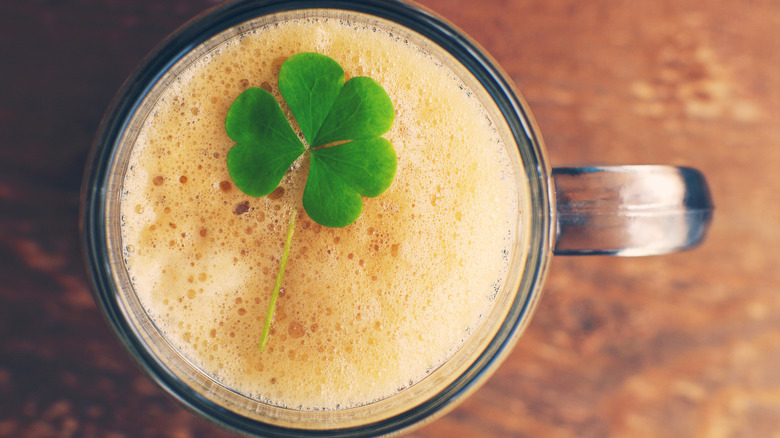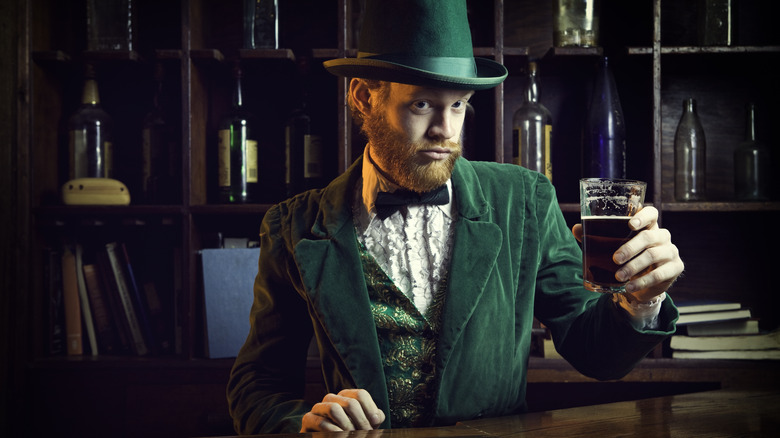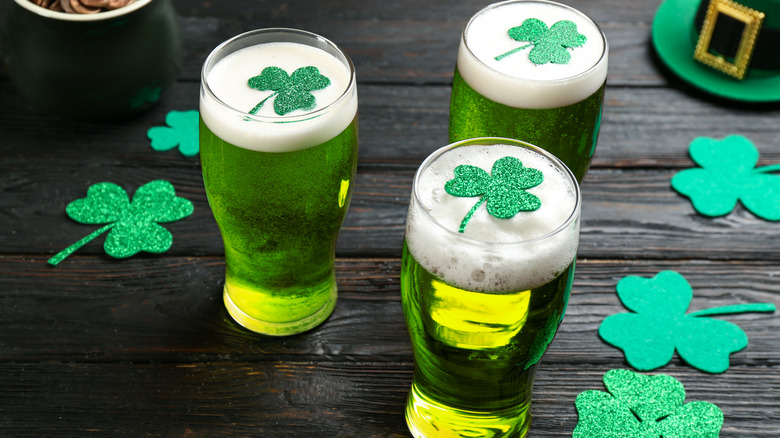How Drinking Beer Became A Rite Of Passage On St. Patrick's Day
It's drawing close to that time of year when we break out our bright green top hats and lucky charms in celebration of Ireland's patron saint while getting a wee bit tipsy. In the U.S., St. Patrick's Day is celebrated with parades, turning our various surroundings a verdant hue, and enjoying a cold one in the company of friends. But the holiday isn't simply an excuse to drink beer. It has a rich history as part of the celebration and originates from the legendary figure himself, Saint Patrick.
Whether the beverage has been colored up or left retaining its golden amber hue, having a beer on St. Paddy's Day is like having a candy cane on Christmas. It doesn't feel quite right unless you've got a hoppy beverage in hand as you belt out an Irish folk song in good company. St. Patrick is known for many things, like driving all the snakes out of Ireland and associating the three-leaf clover with the Christian Holy Trinity, but he was also known for his fondness of a pint. Today, it's often considered a rite of passage to turn 21 (or 18 in Ireland) to have your first St. Paddy's Day pint, and that tradition began with the priest himself enjoying the libation.
Who was St. Patrick?
The Patron Saint of Ireland had a reputation for enjoying a drink, and a full one at that. In Irish folklore, there is a tale about "peaca an tomhais," or "the sin of mismeasure." The story tells of an occasion when the sainted priest walks into an establishment and orders a pint. He was served a drink that wasn't completely full and took issue with what he received. Stifan Ó Cadhla, a lecturer in folklore and ethnology at University College Cork, describes the narrative of Ireland's patron saint responding to the person who gave him a less-than-full drink. As Ó Cadhla told the BBC, "Patrick corrects him and tells him, 'You haven't realised [sic] that this sin of mismeasure is one of the worst sins that you can commit.'"
The man wanted a proper pint, and today, his adoration for the hoppy brew is one of the core elements that makes St. Paddy's Day the special experience it is. But beer wasn't always central to observing the day the storied priest died. Originally, the Irish holiday was honored not just to recognize St. Patrick and his contributions to Ireland, but it also provided a break during Lent, when many Christians abstain from eating meat and drinking alcohol. It was celebrated as a kind of cheat day during the 40-day fast. As beloved as the beverage may be in Ireland, it's not the country that drinks the most beer globally, and it doesn't dye it green on St. Paddy's.
Globalization and green beer
St. Patrick's Day celebrations have evolved over the centuries, and today, Irish and non-Irish folk around the world partake. Parades are attended by young and old, making for a day of spirited fun, all while wearing something suitable for the occasion — and nothing matches an emerald outfit better than a green beer.
The tradition of staining suds is fairly new, historically speaking, and it didn't begin in Ireland. Making beverages jade colored on this festive holiday began with an eye surgeon and coroner's physician, Dr. Thomas Curtin. In the early 1900s, he tinted beer for a St. Patrick's Day celebration at a social gathering in the Bronx by adding a blue dye to the drinks (remember, yellow and blue make green), and the gimmick caught on. Ironically, the Irish don't typically serve sage-colored ale in pubs around the holiday; it's considered an American way to commemorate the occasion.
Since the doctor's contribution to the traditions of St. Paddy's Day, shading everything in emerald tones has become commonplace. Chicago has dyed the Chicago River green for the big day for over sixty years. Other cities, like San Antonio, have followed Chicago's lead by turning their iconic river green while bagpipes sound off in the background. As the bagpipes play, partygoers enjoy lagers and stouts while celebrating Ireland's patron saint. Beer is a central part of the celebration that remembers a man who evangelized on the isle about the Nazarene, but also the importance of getting a full glass when he ordered a brew.


